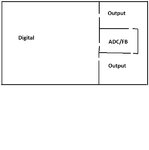kabaleevisu
Advanced Member level 2
- Joined
- Apr 14, 2010
- Messages
- 616
- Helped
- 85
- Reputation
- 170
- Reaction score
- 81
- Trophy points
- 1,308
- Location
- Chennai,India
- Activity points
- 4,512
Hi vikash,
once complete the placement apply the copper in plane area (gnd and power ) and post the gnd and power layer in snapshot
once complete the placement apply the copper in plane area (gnd and power ) and post the gnd and power layer in snapshot
